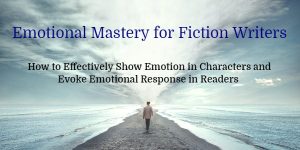Every Novel Scene Should Contain a Death
I hope that catchy title intrigues you. I’ll explain.
I’ve launched my new online course Emotional Mastery for Fiction Writers, and it goes deep into both character and reader emotion.
One very important emotional aspect of a novel is character change. But I bet you haven’t thought of change as a kind of death.
Author and writing instructor James Scott Bell says every scene should contain a death. What does he mean? He’s not talking only about literal death, which might be the case in a suspense/thriller or murder mystery. He means we want our POV character to change by the end of every scene in some small or large way.
In that moment, something should have died: a dream, an opinion, a relationship, a hope, an assumption, a fear or worry … and so on.
Grab a great novel and find a scene that moved you. Skim through it (or take the time to read it carefully—whatever you need). Study the ending. It’s usually the last paragraph or two that showcases the “death” or how the character has changed. How has that change been shown? Look for the emotional tell.
One of my favorite passages to use when teaching my scene structure boot camp is the opening for Candace Fox’s Crimson Lake. Without pasting the entire scene (get this book!), I’ll give you the last few paragraphs.
The protagonist, Ted Conkaffey, is a police detective in Sydney, but because of being in the wrong place at the wrong time, he has been accused but not convicted of a brutal child abduction. He’s fled to the swampy croc-infested north to keep a low profile, but it’s hard to do when your face has been plastered all over the news for months and your life has been destroyed. Ted is trying to find a way to not just survive literally but emotionally. He’s lost his wife and baby girl, his career and reputation—everything.
Making your protagonist a victim of unfortunate circumstance is one the best ways to create an empathetic character, and I can’t think of many situations more unfortunate than this one.
In the opening scene, Ted rescues an injured goose, who has goslings, from the swamp before the crocs get to her. The scene sizzles with an undercurrent of pain, depression, and a host of other emotions, artfully, masterfully conveyed. When he tries to coax the bird to safety—out from the wrong side of a fence—
The goose seemed to rethink the approach and stumbled back, hissing and flapping one great white wing.
“Jesus Christ, are you nuts?” I asked.
I do that when I’m drunk. Talk to things. My gun. Birds. She was nuts though, clearly, waddling around wounded and plump on the banks of the croc-infested Cairns marshlands.
Ted then steps out into the muddy sand, crab holes bubbling.
“Come here.” I waved at the bird, gripping the gate. The goose flapped and squeaked. Her babies gathered together, a terrified bundle of fluff. I looked out at the water again, seemed to spy a hundred black ripples that could have been croc eyes. The sun was down. It was their time now.
He swears at the bird, then rushes forward, lunges at the bird, misses, lunges again, managing to grab a tangle of limbs and claws and feathers. He turns and throws the goose over the fence and into his yard, which is a bit hilarious to picture. The chicks follow, then Ted slams shut the gate, then hauls the birds to the vet.
At the vet he discusses fixing the goose’s leg. He hopes the vet will do it for free, since it’s a wild bird, but that’s not gonna happen. Ted, low on money, gives in to paying for the treatment, and he gives the doctor a fake name when introducing himself.
Here’s how the scene ends:
I took out my wallet and flipped through the red and blue notes. “How much is it to fix a broken goose?”
“It’s a lot, Mr. Collins,” the vet said.
Seven hundred dollars later I drove home trembling and sick and the new owner of a family of domestic geese. It wasn’t the fact that I now had exactly fifty-nine dollars to my name that gave me the shakes. The vet had noticed the name on my credit card was Conkaffey, not Collins. It’s an unusual name. People don’t forget it. And it had only been a month since it was all over the national news. I’d watched his face harden. Watched the lines around his mouth deepen, and then his eyes begin to lift. I grabbed the box of birds and left before I could see the look on his face.
I was sick of that look.
This wrenchingly powerful scene evokes a lot of emotion. Opening with an iconic “pet the cat” moment helps add empathy to this character. He isn’t an animal-rights activist or even an animal lover. We don’t yet know anything about this man’s life, how his life was ruined, that he misses his two-year-old daughter who he hasn’t seen in months.
We don’t know that he is in horrible agony. But we feel it. We sense there is something very wrong. On the first page we learn people have been throwing bricks through his windows. That he’s been drinking a lot and hasn’t yet unpacked boxes in this dilapidated, rotting house. He says,
Between the vigilantes out front and the crocs out the back I felt like I was in prison again, which wasn’t so bad because it was secure. I was free from the decision to run, because I couldn’t run anymore from my crime. Then the gun reminded me, sitting beside me on the dry, cracked wood, that I still had an avenue out.
We realize much later—and so does Ted—why he saved the goose. He notes that since he has no one, maybe he hoped the goose would provide some companionship when he’s utterly lonely. Some hidden emotion moves him to be a savior in this opening scene, and he doesn’t show any affection. But it hints at some need. Pay attention to that.
I suggested you study the ending of various scenes. How does this scene end? How has Ted changed by the end of the scene? What death does he experience?
He hopes the vet won’t recognize him. He hopes he can do some simple ordinary thing, venture out into the open like any normal person and not experience any adverse consequences. He has just moved to the corner of nowhere and wits end.
Is it clear now what dies? The last line gives it away.
His hope to live incognito in this backwater swamp dies. His hope that he can venture out and do anything—go shopping, go to the bank, walk down a street in town—dies. He knows now he will never get a reprieve from the label of child rapist.
And that realization—his reaction and processing that follows the vet’s facial expression—triggers emotional response in the reader.
What do we feel for Ted, even after only four and a half pages? A lot. The author doesn’t tell; she shows. We watch Ted, hear his thoughts in real time, listen to his conversation with the vet. He doesn’t explain too much—practically nothing.
And he doesn’t name any emotions. He doesn’t say “I felt angry, cheated, falsely accused, scared.” He doesn’t even imply he felt anything when he found another brick thrown through the window. The only emotions we see are his annoyance at the bird, perhaps amplified with some fear of croc teeth. He doesn’t show any compassion or worry over the bird or even irritation that the vet won’t fix her. Or anguish over his dwindling bank account.
The only other moment in which we sense emotion from Ted is that last paragraph when he tells us he is trembling and sick. He knew exactly why he felt that way too, and he explains.
Don’t Miss the Purpose of Your Opening Scene
I hope you can see how masterful this scene is. The premise of this novel is centered on his teaming up with a convicted murderer-turned-PI, a nutsy woman, to solve a missing-persons case, which turns out to be a murder (and yes, crocs are involved). Yet, this opening scene does nothing to set up the premise. It’s about this guy saving a goose. Right?
Think about it. The plot action has nothing to do with the premise, but what’s the purpose of the setup scene? If you’ve studied Layer Your Novel and/or taken my online course on The 10 Key Scenes That Frame Your Novel, you know the answer.
The setup scene sets up your protagonist. It’s where you get your reader to care about your character. Even if he’s not a likeable guy, like Sherlock Holmes, readers have to be drawn in with interest to care what happens to him, what happens next.
Most protagonists are meant to be empathetic, because if they’re not, they have to be utterly fascinating and provocative in some other way. In a novel like Gone Girl or Perfume, the awful, unlikeable, even detestable protagonist is compelling and riveting to read about because they are perverse and we’re mesmerized by their character.
Regardless of whether you intend for your reader to like, hate, or be curious about your protagonist, that setup scene has to evoke some emotion. If readers don’t care, they won’t read. Remember: readers read to care. They might care to see the horrible character get his just deserts too.
So, in Crimson Lake, the scene with the goose sets up Ted’s character powerfully. There are plenty of hints to know he’s in trouble. We know he’s suicidal (the scene starts with him saying he was having dark thoughts and staring at his gun at when he found the goose). He could have had thoughts about his wife and daughter, about the terrible situation he is in, and that could have been powerful too. But it’s not until the third scene that we hear what happened to him. And at that point we still don’t know about his wife and daughter.
Great writers drop in little bits of the backstory in subtle ways. They hint at things more than tell them straight.
Why is this masterful? Because it evokes a response in readers. What kind of response? In particular, it makes readers curious. When we write a passage and explain everything, we remove the potential for curiosity. To want to know why and what and how and who.
This is very important to grasp. Since we want readers to react, respond, feel something, if we tell everything, packing our scenes with backstory and explanation, they will have no desire to keep reading. It’s like starting to tell a joke, but immediately giving away the punchline and explaining why the joke is so funny—without allowing the listener to actually hear the joke all the way through and picture the scenario before the punchline is given.
This is part of the surprise we need to stir up in our readers. We want to both surprise readers with their own feelings and let them discover the story through one surprising reveal after another.
If Candace Fox explained everything about Ted’s life and situation in the opening scene, telling exactly how he felt about what happened to him, we wouldn’t need—or be compelled—to keep reading. The mystery would be squelched. There would be nothing surprising left to learn. Maybe the murder mystery plot would be interesting, but much of the emotional power of the story would have leaked out, like air in a balloon with a tiny hole in it.
Be sure every scene you write ends with a death!
I’m excited to announce the launch of my new intensive online video course: Emotional Mastery for Fiction Writers. The course will open at full price on September 1, but if you enroll in the course now (this month, August), you can get half off with this coupon code:EARLYBIRD.
Already four of the modules are live, and you can also view one of them for FREE!
I have scoured the internet and bookstores for years, and I’ve never found anything about the nuts and bolts and mechanics to showing emotion and evoking emotion. Not this deep. Not this practical. Not this concise in the methodology. The how-to.
I want to encourage you to take the plunge and try out this course. Remember, all my online video courses at cslakin.teachable.com have a30-day money-back guarantee! So you have NOTHING to lose and a whole lot of skills and insight to gain by taking this course.
Here’s some of what the course covers:
- The 3 key ways to show emotion in your characters and which one is the most powerful
- What the action-reaction cycle is all about, and why you must understand it to be an emotional master
- Why you need to manipulate your readers’ emotions, and why that’s a good thing
- How to recognize complex emotion and transfer that onto the page
- What microtension is, and why it’s essential for emotional mastery
- Ways to craft mood that will evoke emotion in readers
- How to work at the word, phrase, and sentence level to masterfully convey emotion
- How to find the perfect balance of showing and telling emotion in your characters
- How to deconstruct masterful writing that evokes and shows emotion and emulate the effect in your own scenes
 This course is jam-packed with excerpts from novels, movie clips, handouts, and assignments over 12 modules and many hours of instruction—all designed to help you become an emotional master!
This course is jam-packed with excerpts from novels, movie clips, handouts, and assignments over 12 modules and many hours of instruction—all designed to help you become an emotional master!
This essential instruction is not available anywhere else. There are no books, podcasts, blog posts, or courses that tackle this topic and to this depth. Few writing instructors teach anything pertaining to the emotional craft of fiction. Yet, it is just as important—if not more so—than a great plot or compelling characters.
I’m super excited about this course. I believe it will help you master the toughest skill a fiction writer has to acquire. Are you ready to take the challenge? Sign up now!
Remember, the course will NOT open fully until September 1. I will send enrollees an email to give them the green light to jump in. And you have lifetime access. Tell your writer friends and spread the word. Become a master of emotion so you can write moving stories!












TY. I don’t always keep up with your educational and helpful posts – but glad I saw this one. 😉
Super helpful as I’m working on adding conflict to every scene in my novel. Even when a change creates something good, it destroys something else: when God created the universe, He destroyed the nothingness that preceded it. Humans are more emotionally driven by loss than gain, so examining what’s being destroyed by the change in the scene could help build conflict, especially when it’s felt by the POV character.
Helpful for choosing a POV too, if you’ve got multiple options! Which one has a greater emotional attachment to a “death” in the scene? My opening scene has a character who literally dies and the one who accidentally killed him. The murdered character’s death is important, but for rational reasons, and is too quick for him to feel emotionally. The best POV for the scene is probably the accidental murderer, who recognizes how this will harm others and whose innocence dies to a guilt she will struggle with throughout the story.
Good insights, thanks!
In the case of my central character, it’s almost always his optimism that dies. I sum it up for him in a conversation he has with someone in which he says , “I’m a little like God in that respect. I know what’s going to happen, but I keep hoping people will surprise me.”